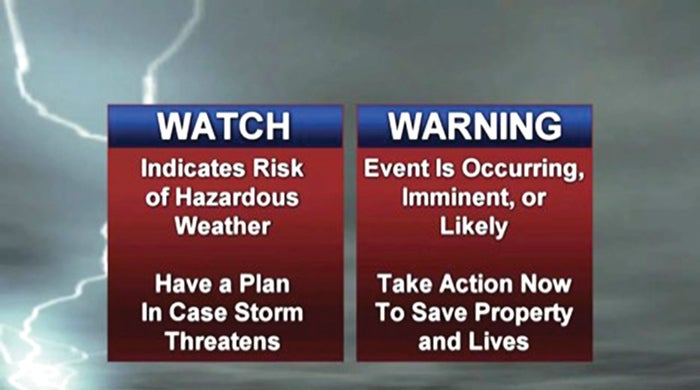Weather Wednesday: Understanding the difference between a watch and a warning
Published 12:00 am Wednesday, July 4, 2018

- Graphic by Steve Monday A watch means severe weather is possible. A warning means severe weather is approaching or occurring now. Know the difference.
By Steve Monday
Rowan County Weather
The scorching, heat-filled days of summer are upon us in Rowan County. We have already had 13 days of temperatures of 90 degrees or higher.
As the heat builds, we will continue to see afternoon and evening thunderstorms as a possibility. We have been in a pattern over the past few weeks with pop-up showers and storms that move through the county late in the day.
Sometimes the need for the National Weather Service to issue a watch or warning for these storms comes into play.
I wanted to take a moment with this week’s column to inform you about the difference between a severe thunderstorm watch and a severe thunderstorm warning. It is important for you to know what they mean and the action you should take.
Severe thunderstorm watch
A severe thunderstorm watch is issued when severe thunderstorms are possible in and near the watch area. It does not mean that they will occur; it only means they are possible.
Severe thunderstorms are defined as follows: Winds of 58 mph or higher and/or hail 1 inch in diameter or larger.
Action you should take for a severe thunderstorm watch
During a thunderstorm watch, stay informed so that you’ll be aware if a warning is issued. You can do this by listening to a weather radio station, following Rowan County Weather on social media and at www.rowancountyweather.com, or listening to local weather forecasts on television.
Severe thunderstorm warning
A severe thunderstorm warning is issued when severe thunderstorms are occurring or imminent in the warning area.
Severe thunderstorms are defined as follows: Winds of 58 mph or higher and/or hail 1 inch in diameter or larger.
Action you should take during a severe thunderstorm warning
If a severe thunderstorm warning is issued, continue to listen for more information and be prepared to act if necessary.
Hail, lightning and strong straight-line winds can sometimes develop during a severe thunderstorm. Straight-line winds are common and dangerous. They can knock down limbs or entire trees and damage homes and other buildings, in addition to causing power outages.
Tornadoes can sometimes develop along with severe thunderstorms. It may be necessary to take shelter away from windows, or to get in the center of your home or in your basement if you have one.
The best thing you can do if severe weather is forecast is to stay informed. Remember to remain calm and have an emergency plan in place for your family should you ever need to use it.
Knowing the difference between a watch and warning will better prepare you when severe weather approaches.
Criteria for watches and warnings are determined by the National Weather Service.



